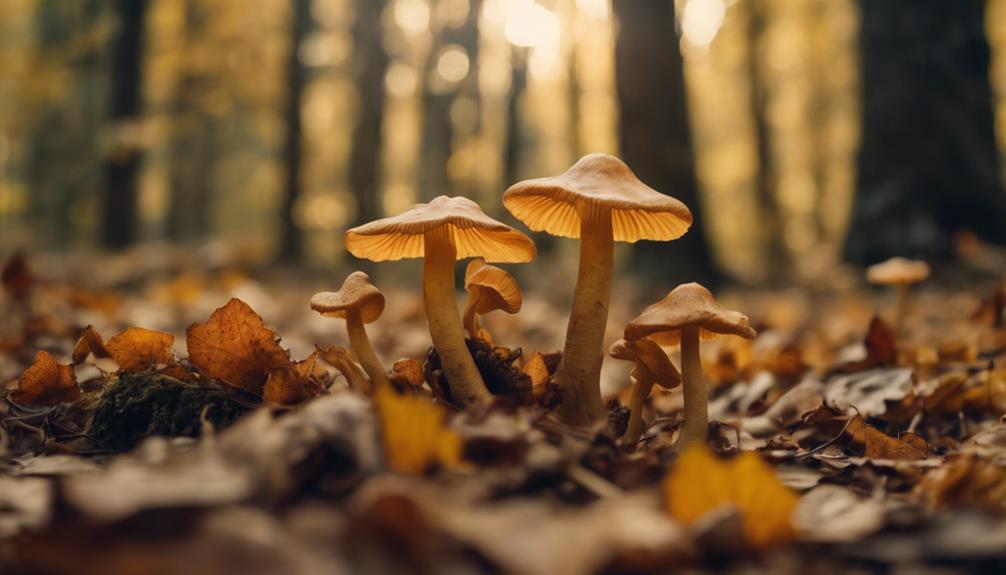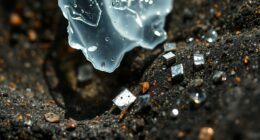To build a local foraging map, start by sketching your area on paper, marking edible plants, landmarks, and seasonal notes with symbols or colors. Use GPS-enabled apps for precise digital locations, add photos, and jot down detailed info on each site. Regularly revisit and update both maps to track plant abundance and growth. Keep improving your recognition skills, and explore more tips to create a sustainable, effective guide for foraging success.
Key Takeaways
- Use detailed sketches or GPS apps to mark edible plant locations and landmarks for easy navigation.
- Incorporate symbols, color codes, and notes to indicate plant edibility, abundance, and seasonal availability.
- Regularly revisit sites to update plant status, growth patterns, and seasonal changes for accuracy.
- Add photos, detailed descriptions, and seasonal info to digital maps for enhanced identification and sharing.
- Include landmarks like rivers, trails, and notable trees to facilitate future foraging trips and site revisits.

Creating a local foraging map is an empowering way to discover natural resources in your area and deepen your connection with the environment. When you focus on wild edible plants, you unlock a world of seasonal foraging opportunities that can enhance your meals and boost your knowledge of local ecosystems. To start, you’ll want to familiarize yourself with the native flora in your region. Invest in a good field guide or use reliable online resources to identify common wild edible plants. As you explore your surroundings, note which plants are available during different times of the year, paying attention to their seasonal cycles. This will help you plan for foraging trips when specific plants are in peak abundance and safe to harvest.
Mapping these plants involves both observation and record-keeping. If you prefer the traditional approach, you can create a paper map by sketching your area and marking locations of edible plants as you find them. Use symbols or color codes to indicate which plants are edible, which are best for seasonal foraging, and any notes on abundance or risk factors. Be sure to include landmarks, such as rivers, trails, or notable trees, so you can easily find these spots again. As you gain confidence, you’ll develop a mental map of where to go for particular wild edible plants, making future foraging trips more efficient and enjoyable. Additionally, understanding native flora and their habitats will improve your foraging success and sustainability.
Create a detailed paper map marking edible plants, landmarks, and seasonal notes to enhance your foraging journey.
If you lean toward digital tools, there are many apps designed for mapping and documenting foraging sites. You can use GPS-enabled maps to mark locations, add photos, and write notes about each spot. Digital maps allow you to access your foraging data on the go and share your discoveries with a community of foragers if you choose. Many apps also provide seasonal information, helping you track when specific plants are in their prime for harvest. This adaptability makes digital maps especially useful for seasonal foraging, as you can update them throughout the year to reflect changing plant availability and growth patterns.
Whether you choose paper or digital, building a foraging map requires ongoing observation and documentation. Regularly revisit your sites, update your notes, and refine your understanding of the local edible landscape. As you do, you’ll become more skilled at recognizing wild edible plants and understanding their seasonal cycles. Over time, your map will serve as a valuable guide, helping you harvest safely and sustainably, while deepening your connection with nature. This process not only expands your foraging skills but also fosters a greater appreciation for the natural abundance right in your backyard.
Frequently Asked Questions
What Tools Are Best for Digital Foraging Maps?
You should use mapping software like ArcGIS or QGIS for digital foraging maps, as they offer robust features for plant identification and detailed mapping. Apps like iNaturalist can also help with identifying plants on the go. These tools enable you to mark locations, add notes, and share your maps easily, making your foraging more organized and accurate. Combining plant identification apps with mapping software creates a powerful digital foraging map.
How Often Should I Update My Foraging Map?
You should update your foraging map seasonally to guarantee map accuracy and reflect changes in plant availability. Regular updates, ideally every few months or when you notice seasonal shifts, help you stay current with new growth or hazards. By doing so, you keep your map reliable, safe, and useful for sustainable foraging. Consistent updates also help you learn seasonal patterns and adapt your foraging practices accordingly.
Are There Legal Considerations for Foraging Locations?
You need to prioritize legal compliance when foraging by always securing landowner permissions before accessing private property. Check local regulations and protected areas to avoid fines or legal trouble. Respect designated land use rules and restrictions, especially in parks or conservation zones. Staying informed about legal considerations guarantees you forage responsibly and ethically, protecting both your access and the environment.
How Do I Identify Edible Versus Poisonous Plants?
To identify edible versus poisonous plants, focus on proper plant identification by studying guidebooks, apps, or consulting experts. Always verify key features like leaf shape, flowers, and growth habits. Follow safety precautions by never consuming plants unless you’re 100% sure of their identity, and consider doing a test patch for new plants. When in doubt, err on the side of caution to avoid poisoning.
Can I Share My Foraging Map Publicly?
Sharing your foraging map publicly is possible, but you should prioritize ethical harvesting and conservation practices. By responsibly sharing, you help foster community curiosity and conservation consciousness. Guarantee your map promotes sustainable foraging, highlights protected plants, and discourages over-harvesting. Consider adding notes on ethical practices, and always respect local laws. When you share thoughtfully, you inspire responsible foraging and protect precious plant populations for future foragers.
Conclusion
Now that you’ve started mapping your local foraging spots, remember—there’s always more to discover just beyond the edge of your map. Each new location holds secrets, wild edibles waiting to be found, and stories yet to be uncovered. Keep exploring, stay curious, and trust that your journey has only just begun. The true treasure lies not only in what you find but in the adventure that keeps calling you back. Keep going—you never know what’s next.










